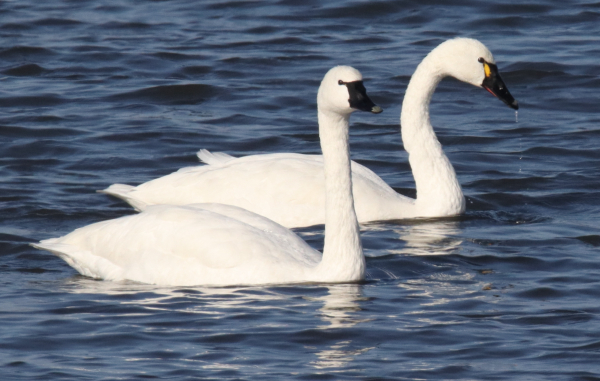
A vanguard of Tundra Swans migrated into the region last week, including a pair that foraged in the shallows of a long lake just a mile from The Birding Wire office.
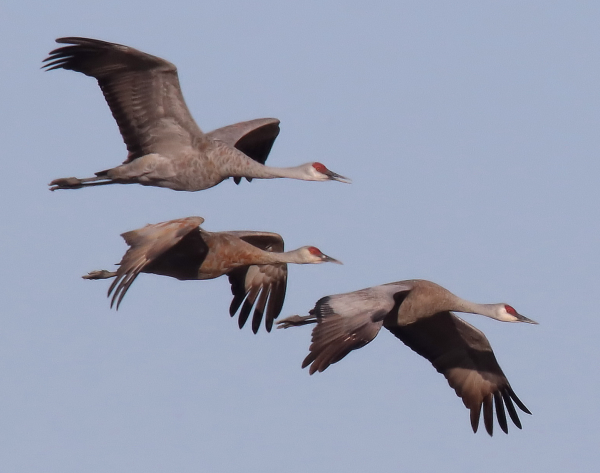
A migration of Sandhill Cranes was encountered nearby Sunday morning, composed of 15 flocks numbering about 260 cranes.
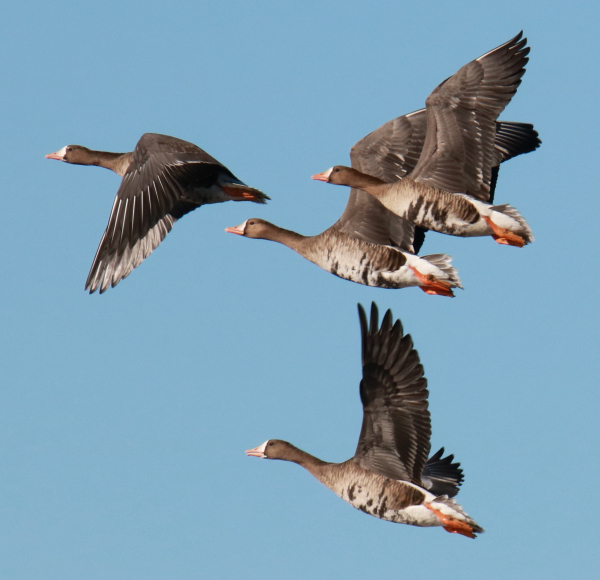
White-fronted Geese have been among the first Arctic-nesting geese to advance into the region, and the first 8 Snow Geese led the way for hundreds of thousands to follow.
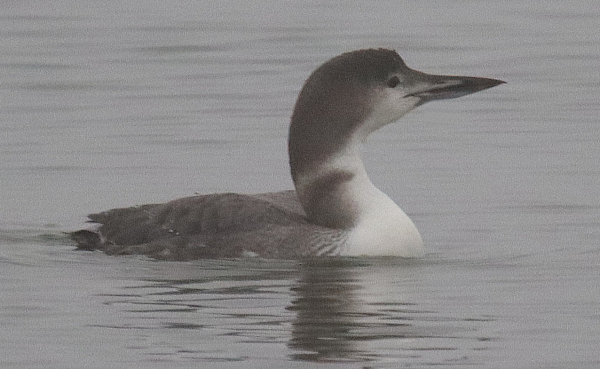
Foggy conditions Thursday afternoon affected the quality of photos possible when a pair of Common Loons appeared on a nearby lake – the first pair observed in the area to my knowledge.
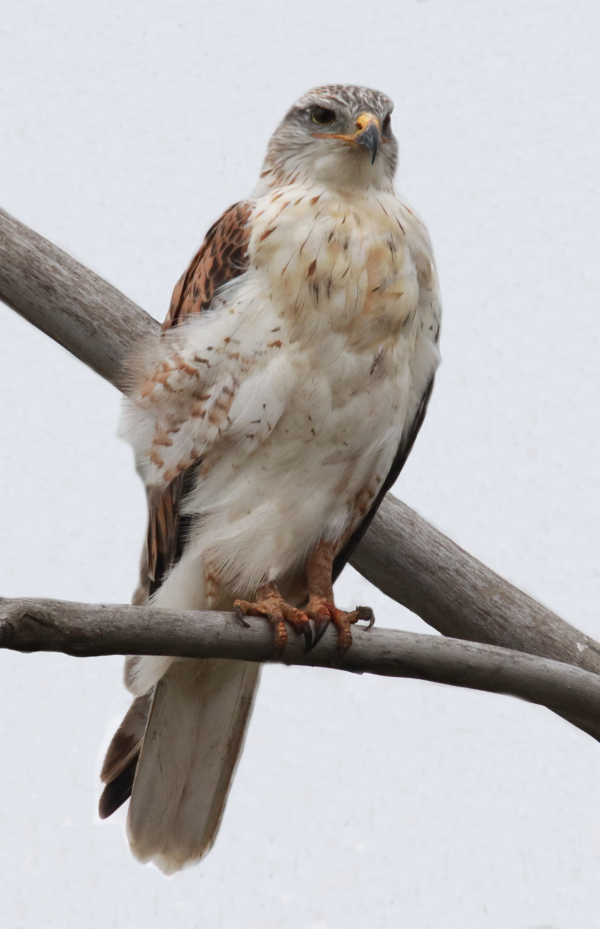
A late season sighting of a Ferruginous Hawk at the same location where a pair was sighted in early April created an interesting backstory.
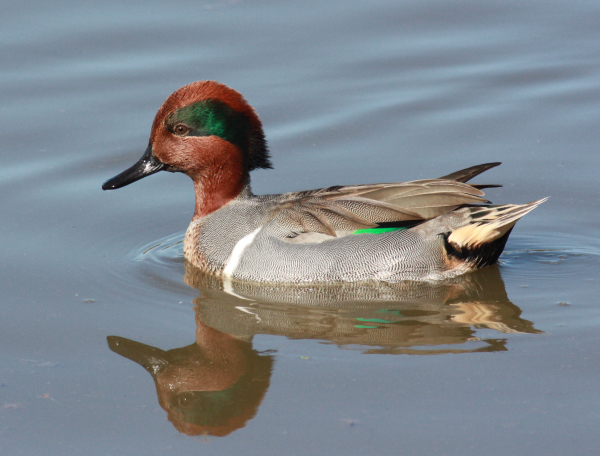
Among the variety of at least 13 species of ducks now stopping over at area marshes and lakes, a few small flocks of Green-winged Teal are present including a colorful male that was among a group of 4.
|
After a couple windy days, Sunday morning was pretty calm and while my birding drive 15 miles east was mostly uneventful, as I turned back a V-shaped flock was winging across “hawk valley.” A binocular view revealed the flock was made up of about 25 Sandhill Cranes, as were the next 11 flocks that followed in a long line of migrating flocks, all voicing their classic calls. I estimated a total of 170 Sandhills, and 3 miles to the east I intercepted 2 more flocks of cranes that added 90 more to my total (260). After turning south I checked on another flock that turned out to be 35 White-fronted Geese – what great migration sightings!
American Crows were another migrating species encountered, with 2 flocks numbering 22 and 50ish; crow sightings are uncommon in the open plains any season of the year. There were also a few large flocks of small songbirds that had white undersides and tan tops – native sparrows or buntings likely, but I couldn’t get a positive ID. Raptors included 5 Northern Harriers and 5 Red-tailed Hawks, and a few large flocks of Lesser Scaup were most obvious in the duck mix, as were small flocks of Mallards and Ruddy Ducks. It was especially rewarding to see the first family group of Tundra Swans feeding in the shallows of a long lake just a mile northwest of home, an adult pair with 2 gray cygnets.
Headed for Bismarck
With Tundra Swans and Rough-legged Hawks in mind while driving to Bismarck Wednesday, I made it a point to pass by many of the best swan stopover lakes along the way, as well as plenty of Rough-leg grassland habitat. Even so, for the first hour the breakthrough migrants were a small flock of about 15 White-fronted Geese on the edge of a larger flock of about 80 Canada Geese – not the Giant Canadas from this area, but the smaller, regular-sized Canada Geese from Canada.
It wasn’t until I reached the shallow bay on the south side of Long Lake Refuge that I found a pair of Tundra Swans, but the real surprise was a large gathering of 21 adult Tundra Swans on the south end of McKenzie Slough, east of Bismarck, a place where swans are not commonly encountered. It was fun to see such a large group and to hear their Arctic calls to accent the fall season.
Rewind to Long Lake National Wildlife Refuge, an expansive flock of Canada Geese was present at a favorite waterfowl wetland a mile north of the refuge, but that was just the beginning of the goose-capade. Two harvested wheat fields held big flocks of White-fronted Geese, numbering about 250 and 350, with 4 standout white geese among the first flock – the first Snow Geese of fall! And as I stood outside my auto where I could enjoy the sounds of the White-fronts, another flock of 4 adult Snow Geese flew low overhead to join the 4 among the other Arctic-nesting geese.
I looked in vain for Sandhill Cranes in the refuge area, but there was a big throng of Mallards numbering in the hundreds. Only a very few White Pelicans were still present, but many Double-crested Cormorants and American Coots were on hand with a Great Blue Heron and 2 Great Egrets in areas I surveyed. There were no Rough-legs to be seen along my route that day, but there were 21 Red-tailed Hawks, 6 Northern Harriers, and 3 American Kestrels. I also observed a lone Sharp-tailed Grouse and 2 lone male Ring-necked Pheasants; and there were occasional small flocks of Western Meadowlarks and Horned Larks, the latter from the north, possibly the former too.
Ducks were sprinkled through the wetlands along my extended birding drive, but one significant mixed flock of ducks included about 60 Canvasbacks, 250 Lesser Scaup, and 50 Ruddy Ducks, all obviously in transit as migrants. It was the first significant flock of scaup and it was clear this mid-October birding drive surely revealed that the vanguard of fall migration was at hand.
Autumn Beauty – At home, the scene outside my 4 bay windows was colored at its peak in yellow, gold, red, and orange leaves – on the trees and on the ground. All this was punctuated by the occasional visitor to the trees and feeding station, including the first Pine Siskins of fall, a Brown Creeper, a Downy Woodpecker, and a Ruby-crowned Kinglet through Friday. I even had a tight group of 4 flocks of Canada Geese fly overhead about noon Friday, including 1 flock of noticeably smaller Canadas (Cackling Geese?).
Beginning Saturday, a female Purple Finch was the first visitor, followed by a flock of Dark-eyed Juncos with a young White-crowned Sparrow among them and Blue Jays calling in the area. Sunday a White-breasted Nuthatch was the first of its kind to appear in several days. Sunday, after seeing the flock of White-fronted Geese and Sandhill Cranes during my morning drive, as I was replacing the suet in my feeding station I heard the unique calls of White-fronted Geese, and looked up to see a flock of about 40 flying directly overhead pointed south – nice. Blue Jays were vocal outdoors after a morning rain Monday, and as I worked I hoped one of the colorful jays might land among the gold or red foliage outside my windows.
Gloomy Thursday Surprises
When I least expected it, after seeing very few birds during a 17 mile drive to the south, the first thrill of the day happened to be an “orange hawk” – a very late appearance by a Ferruginous Hawk. This raptor sighting was significant for a number of reasons, partly because it was so late in the season, and because this location is at the eastern edge of the Ferruginous Hawk’s range (I don’t recall seeing one farther east for decades), and this location has a special story behind it with regard to Ferruginous Hawks.
At the other end of the spectrum, I was really surprised to see a pair of Common Loons 6 miles north of home – the first pair of loons I’ve ever seen in the area and the farthest west I’ve seen the species overall. While I have seen 2 single Common Loons during fall migration (both first-fall birds), and 1 adult loon during spring migration, seeing a pair in mid-October in this area was quite a significant sighting. Actually, I describe the loon and hawk sightings in more detail with photo illustrations in the Bird Photography feature in this issue of The Birding Wire, so I will refer you to that article for more insights.
Friday morning I checked back to see if I could re-find the loons and Ferruginous Hawk without finding a trace, but it was nice to recall they were on site at the 2 locations less than 20 hours earlier. In the meantime along that birding drive I was glad to see a variety of birds, ranging from an adult Bald Eagle and a single Tundra Swan to a flock of 19 Long-billed Dowitchers. There was still a Western Grebe on hand, along with a Pied-billed Grebe, a lone White Pelican, and a couple sizeable flocks of American Coots. Ducks included a flock of 8 Hooded Mergansers, 3 small flocks of Buffleheads numbering 4, 3, and 14; a super-flock of about 40 Canvasbacks and 80 Lesser Scaup, and a tight flock of 15 Redheads were observed; plus there were small flocks of Gadwalls, Northern Shovelers, and Mallards. A single Greater Yellowlegs was present as was a loose flock of 4 Lesser Yellowlegs, a few small flocks of Western Meadowlarks and American Robins, and finally, raptors included 3 Red-tailed Hawks and 2 Northern Harriers.
During a windy Saturday birding drive to the south, ducks were most obvious, including Mallards, Canvasbacks, Lesser Scaup, Redheads, Ruddy Ducks, Green-winged Teal, and a small flock of Buffleheads. There was also a flock of almost 50 Western Grebes on a big lake, a Northern Flicker and a flock of 5 Sharp-tailed Grouse along the way, and in the wind there were 4 active Northern Harriers but only a single Red-tailed Hawk. Birds have been especially active over the last week as I searched them out almost daily, and I hope you have a birdy week ahead – it’s a fine period of the fall, and it will only get better – Enjoy!
Article and Photos by Paul Konrad
Share your bird sightings and photographs at editorstbw2@gmail.com